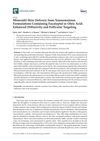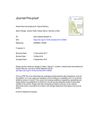TLDR Microemulsions and nanoemulsions can effectively deliver drugs through the skin, but more research is needed to understand their differences and mechanisms.
Microemulsions and nanoemulsions are promising vehicles for (trans)dermal drug delivery due to their ability to safely transport clinically relevant drug doses across biological membranes. Their effectiveness is largely attributed to their small dispersion size, which enhances skin permeation. However, the literature lacks clear distinctions between microemulsions and nanoemulsions regarding their definitions, behavior, and specific mechanisms of action. This review aims to deepen the understanding of these vehicles by examining their composition and the role of system constituents in affecting skin structures and drug permeability. It highlights the need for further exploration of mesostructures and the impact of cosolvents, oils, and water on permeation profiles, focusing on formulation systems using ternary diagrams with non-ionic surfactants and other common pharmaceutical components.
26 citations
,
January 2024 in “Gels” Nanoemulgels could effectively treat skin diseases and may replace or complement current therapies.
 2 citations
,
May 2023 in “Nanomaterials”
2 citations
,
May 2023 in “Nanomaterials” Microemulsions could improve skin drug delivery but face challenges like complex creation and potential toxicity.
 5 citations
,
January 2022 in “Drug Delivery”
5 citations
,
January 2022 in “Drug Delivery” Bimatoprost cream can help regrow hair in baldness.
 40 citations
,
January 2018 in “Pharmaceutics”
40 citations
,
January 2018 in “Pharmaceutics” Eucalyptol and oleic acid in nanoemulsions improve minoxidil delivery to hair follicles, potentially enhancing hair loss treatment.
 29 citations
,
June 2014 in “Drug delivery”
29 citations
,
June 2014 in “Drug delivery” The new formulation improved the skin absorption of the drug Thiocolchicoside.
 39 citations
,
September 2016 in “Expert Opinion on Drug Delivery”
39 citations
,
September 2016 in “Expert Opinion on Drug Delivery” New drug delivery methods can make natural compounds more effective and stable.
54 citations
,
June 2020 in “Pharmaceutics” New nanocarriers improve drug delivery for disease treatment.
 67 citations
,
January 2022 in “Theranostics”
67 citations
,
January 2022 in “Theranostics” Advanced nanocarrier and microneedle drug delivery methods are more effective, safer, and less invasive for treating skin diseases.
 36 citations
,
September 2019 in “Journal of Herbal Medicine”
36 citations
,
September 2019 in “Journal of Herbal Medicine” Herbal nano-formulations show potential for effective skin delivery but need more research.
 33 citations
,
July 2021 in “Clinical, Cosmetic and Investigational Dermatology”
33 citations
,
July 2021 in “Clinical, Cosmetic and Investigational Dermatology” Nanocarrier technology in cosmetics improves ingredient delivery and effectiveness while reducing side effects.







